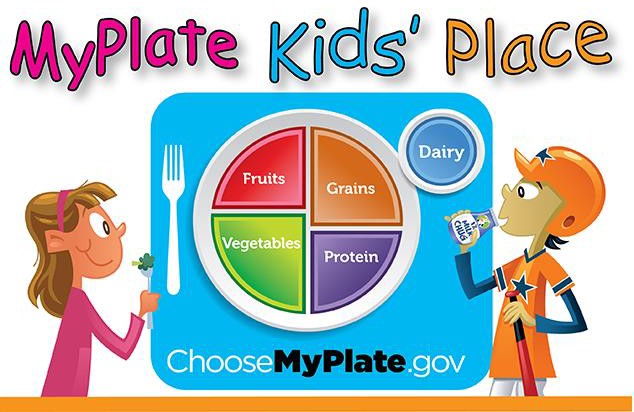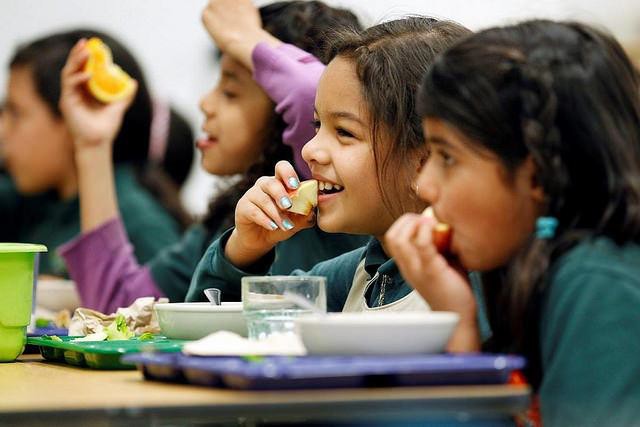80 Nutritional Needs
A number of factors can influence children’s eating habits and attitudes toward food. Family environment, societal trends, taste preferences, and messages in the media all impact the emotions that children develop in relation to their diet. Television commercials can entice children to consume sugary products, fatty fast foods, excess calories, refined ingredients, and sodium. Therefore, it is critical that parents and caregivers direct children toward healthy choices.[1]
Parents greatly impact their child’s nutritional choices. This time in a child’s life provides an opportunity for parents and other caregivers to reinforce good eating habits and to introduce new foods into the diet, while remaining mindful of a child’s preferences. Parents should also serve as role models for their children, who will often mimic their behavior and eating habits. Parents must continue to help their school-aged child establish healthy eating habits and attitudes toward food. Their primary role is to bring a wide variety of health-promoting foods into the home, so that their children can make good choices.[2]
Let’s think for a moment about what our parents and grandparents used to eat? What are some of the differences that you may have experienced as a child?
One hundred years ago, as families sat down to dinner, they might have eaten boiled potatoes or corn, leafy vegetables such as cabbage or collards, fresh-baked bread, and, if they were fortunate, a small amount of beef or chicken. Young and old alike benefitted from a sound diet that packed a real nutritional punch. Times have changed. Many families today fill their dinner plates with fatty foods, such as French Fries cooked in vegetable oil, a hamburger that contains several ounces of ground beef, and a white-bread bun, with a single piece of lettuce and a slice or two of tomato as the only vegetables served with the meal.

Our diet has changed drastically as processed foods, which did not exist a century ago, and animal-based foods now account for a large percentage of our calories. Not only has what we eat changed, but the amount of it that we consume has greatly increased as well, as plates and portion sizes have grown much larger. All of these choices impact our health, with short- and long-term consequences as we age. Possible effects in the short-term include excess weight gain and constipation. The possible long-term effects, primarily related to obesity, include the risk of cardiovascular disease, diabetes, hypertension, as well as other health and emotional problems for children. Centers for Disease Control and Prevention. “Overweight and Obesity: Health Consequences.”[3]
During middle childhood, a healthy diet facilitates physical and mental development and helps to maintain health and wellness. School-aged children experience steady, consistent growth, but at a slower rate than they did in early childhood. This slowed growth rate can have lasting a lasting impact if nutritional, caloric, and activity levels aren’t adjusted in middle childhood which can lead to excessive weight gain early in life and can lead to obesity into adolescence and adulthood.[4]
Making sure that children have proper nutrients will allow for optimal growth and development. Look at the figure below to familiarize yourself with food and the place setting for healthy meals.

One way to encourage children to eat healthy foods is to make meal and snack time fun and interesting. Parents should include children in food planning and preparation, for example selecting items while grocery shopping or helping to prepare part of a meal, such as making a salad. At this time, parents can also educate children about kitchen safety. It might be helpful to cut sandwiches, meats, or pancakes into small or interesting shapes. In addition, parents should offer nutritious desserts, such as fresh fruits, instead of calorie-laden cookies, cakes, salty snacks, and ice cream. Studies show that children who eat family meals on a frequent basis consume more nutritious foods.[5]
Video reviews tips for healthy eating during middle childhood.
Energy
Children’s energy needs vary, depending on their growth and level of physical activity. Energy requirements also vary according to gender. Girls require 1,200 to 1,400 calories a day from age 2 to 8 and 1,400-1,800 for age 9 to 13. Boys also need 1,200 to 1.400 calories daily from age 4 to 8 but their daily caloric needs go up to 1,600-2,000 from age 9 to 13. This range represents individual differences, including how active the child is.[6]
Recommended intakes of macronutrients (protein, carbohydrates, and fats) and most micronutrients (vitamins and minerals) are higher relative to body size, compared with nutrient needs during adulthood. Therefore, children should be provided nutrient-dense food at meal- and snack-time. However, it is important not to overfeed children, as this can lead to childhood obesity, which is discussed in the next section.
Children and Vegetarianism
Another issue that some parents face with school-aged children is the decision to encourage a child to become a vegetarian or a vegan. Some parents and caregivers decide to raise their children as vegetarians for health, cultural, or other reasons. Preteens and teens may make the choice to pursue vegetarianism on their own, due to concerns about animals or the environment. No matter the reason, parents with vegetarian children must take care to ensure vegetarian children get healthy, nutritious foods that provide all the necessary nutrients.
Types of Vegetarian Diets
There are several types of vegetarians, each with certain restrictions in terms of diet:
- Ovo-vegetarians. Ovo-vegetarians eat eggs, but do not eat any other animal products.
- Lacto-ovo-vegetarians. Lacto-ovo-vegetarians eat eggs and dairy products, but do not eat any meat.
- Lacto-vegetarians. Lacto-vegetarians eat dairy products, but do not eat any other animal products.
- Vegans. Vegans eat food only from plant sources, no animal products at all.

Children who consume some animal products, such as eggs, cheese, or other forms of dairy, can meet their nutritional needs. For a child following a strict vegan diet, planning is needed to ensure adequate intake of protein, iron, calcium, vitamin B12, and vitamin D. Legumes and nuts can be eaten in place of meat, soy or almond milk fortified with calcium and vitamins D and B12 can replace cow’s milk. Parents must be informed and knowledgeable in order to support proper development for children with a vegetarian or vegan diet.[7]
Children and Malnutrition
Many may not know that malnutrition is a problem that many children face, in both developing nations and the developed world. Even with the wealth of food in North America, many children grow up malnourished, or even hungry. The US Census Bureau characterizes households into the following groups:
- food secure
- food insecure without hunger
- food insecure with moderate hunger
- food insecure with severe hunger
Millions of children grow up in food-insecure households with inadequate diets due to both the amount of available food and the quality of food. In the United States, about 20 percent of households with children are food insecure to some degree. In half of those, only adults experience food insecurity, while in the other half both adults and children are considered to be food insecure, which means that children did not have access to adequate, nutritious meals at times.[8]
Growing up in a food-insecure household can lead to a number of problems. Deficiencies in iron, zinc, protein, and vitamin A can result in stunted growth, illness, and limited development. Federal programs, such as the National School Lunch Program, the School Breakfast Program, and Summer Feeding Programs, work to address the risk of hunger and malnutrition in school- aged children. They help to fill the gaps and provide children living in food-insecure households with greater access to nutritious meals.[9]
Video discusses hunger and food insecurity.
School Lunch Programs[10]
Many school age children eat breakfast, snacks, and lunch at their schools. Therefore, it is important for schools to provide meals that are nutritionally sound. In the United States, more than thirty-one million children from low-income families are given meals provided by the National School Lunch Program. This federally funded program offers low-cost or free breakfast, snacks, and lunches to school facilities. School districts that take part receive subsidies from the US Department of Agriculture (USDA) for every meal they serve that must meet 2015 Dietary Guidelines for Americans.
Knowing that many children in the United States buy or receive free lunches in the school cafeteria, it might be worthwhile to look at the nutritional content of school lunches. You can obtain this information through your local school district’s website. An example of a school menu from a school district in north central Texas is a meal consisting of pasta alfredo, bread stick, peach cup, tomato soup, a brownie, and 2% milk which is in compliance with Federal Nutritional Guidelines. Consider another menu from an elementary school in the state of Washington. This sample meal consists of chicken burger, tater tots, fruit, veggies, and 1% or nonfat milk. This meal is also in compliance with Federal Nutrition Guidelines but has about 300 fewer calories than the menu in Texas. This is a big difference in calories and nutritional value of these prepared lunches that are chosen and approved of by officials on behalf of children in these districts.

Healthy School Lunch Campaigns helps to promote children’s health. This is done by educating government officials, school officials, food-service workers, and parents and is sponsored by the Physicians Committee for Responsible Medicine. They educate and encourage schools to offer low-fat, cholesterol-free options in school cafeterias and in vending machines and work to improve the food served to children at school. Unfortunately, many school districts in the nation allow students to purchase chips, cookies, and ice cream along with their meals. These districts rely on the sale of these items in the lunchrooms to earn additional revenues. Not only are they making money off of children and families with junk food, they are also adding additional empty calories to their daily intake. These districts need to look at the menus and determine the rationale for offering additional snacks and desserts for children at their schools. Whether children receive free lunches, buy their own, or bring their lunch from home, quality nutrition is what is best for these growing bodies and minds.
- Research on the Benefits of Family Meals. Dakota County, Minnesota. Updated April 30, 2012. Accessed December 4, 2017 ↵
- Childhood by University of Hawai’i at Mānoa Food Science and Human Nutrition Program is licensed under CC BY-NC-SA 4.0 ↵
- An Introduction to Nutrition by Maureen Zimmerman and Beth Snow is licensed under CC BY-NC-SA 3.0 ↵
- Childhood by University of Hawai’i at Mānoa Food Science and Human Nutrition Program is licensed under CC BY-NC-SA 4.0 (modified by Dawn Rymond) ↵
- Research on the Benefits of Family Meals. Dakota County, Minnesota. Updated April 30, 2012. Accessed December 4, 2017 ↵
- Parent Tips – Calories Needed Each Day by the NIH is in the public domain ↵
- An Introduction to Nutrition by Maureen Zimmerman and Beth Snow is licensed under CC BY-NC-SA 3.0 ↵
- Coleman-Jensen A, et al. Household Food Security in the United States in 2010. US Department of Agriculture, Economic Research Report, no. ERR-125; 2011 ↵
- Lifespan Development - Module 6: Middle Childhood by Lumen Learning references Psyc 200 Lifespan Psychology by Laura Overstreet, licensed under CC BY 4.0 (modified by Dawn Rymond). Childhood by University of Hawai’i at Mānoa Food Science and Human Nutrition Program is licensed under CC BY- NC-SA 4.0 (modified by Dawn Rymond) ↵
- [footnote]Lifespan Development - Module 6: Middle Childhood by Lumen Learning references Psyc 200 Lifespan Psychology by Laura Overstreet, licensed under CC BY 4.0 (modified by Dawn Rymond). Childhood by University of Hawai’i at Mānoa Food Science and Human Nutrition Program is licensed under CC BY- NC-SA 4.0 (modified by Dawn Rymond) ↵

